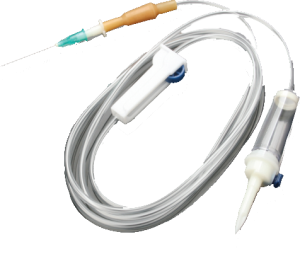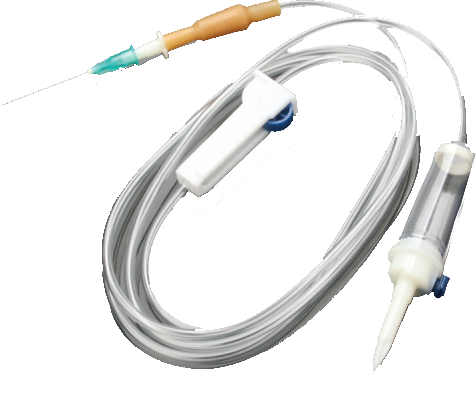Infusion Sets/ IV Sets
Infusion Sets/ IV Sets: Infusion is a medical process involving rapid or slow substance introduction directly into the vein or in some cases between tissues. Intravenous (IV) therapy can be performed any time a patient needs blood, drugs, or electrolytes. The infusion IV supplies used to accomplish this type of therapy include access devices in the form of a needle, Peripheral IV line (PIV), or central IV line. Central intravenous lines are applied to specific veins within the body. They offer certain advantages over other methods like the ability to deliver fluids that PIVs are sensitive to, they faster bodily distribution, and they have ability to apply multiple types of liquids at the same time.
A standard set includes a sterile container such as a plastic bag with a drop attachment for flow rate control, sterile tubing with clamps to stop flow or regulate the rate, and an access device with connectors. Infusion pumps provide the ability to have precise control regarding how much fluid is delivered and the set rate. Rapid infusers in the form of warmers or inflatable cuffs are sometimes used when a high flow rate is required. Blood-based products, medications, and nutritional solutions are common items supplied to a patient using this medical process.
IV Fluids: Measures Can Be Taken to Decrease Administration Risks
The administration of IV fluids can result in adverse effects even when the utmost precautions are taken. Infection is one of the largest concerns because any skin break has this risk. Bacteria have the ability to enter the entry site or can be introduced through contaminated equipment. The problem is often local; however, bacteria are capable of spreading throughout the entire body by means of the bloodstream, consequently causing a life-threatening scenario. Additional complications can arise as IV fluids are delivered to a patient including:
- Vein Inflammation
- Infiltration
- Extravasation
- FluidOverloading
- Hypothermia
- Imbalances
- Blood Clots
- Air Bubbles
The risk of infection, while not completely avoidable, is reduced by using new sterile supplies for every application, minimizing area cleaning, frequent changing, and eliminating devices with the possibility of carrying bacteria. Vein inflammation is most often due to the introduction of a foreign body or a direct patient reaction. Infiltration or extravasation involves substance entry into the tissue as opposed to the vein. The complication is extremely common and only dangerous if the medication poses damage to the surrounding tissue. Overloading occurs when the substances are supplied at too high of a rate or too large of a volume than what can be handled by the body.
Hypothermia is the result of an extreme internal bodily temperature drop with the most common association being when a person develops the condition due to outside cold; however, it can also be a directly caused by cold fluid entry. Given liquids are stored at a temperature below normal body heat and cause a significant decrease if delivered rapidly. Warmers prevent hypothermia when extensive amounts of a substance must be introduced to the patient rapidly. Numerous professionals are switching to disposable device administration in an effort to reduce both of these risks. New designs are portable, use battery power, work with standard infusion IV supplies, and have improved flow rate efficiency.
Get best quality Infusion Sets/ IV Sets & other
healthcare equipments online from
Nexgen Medical at wholesale price.

